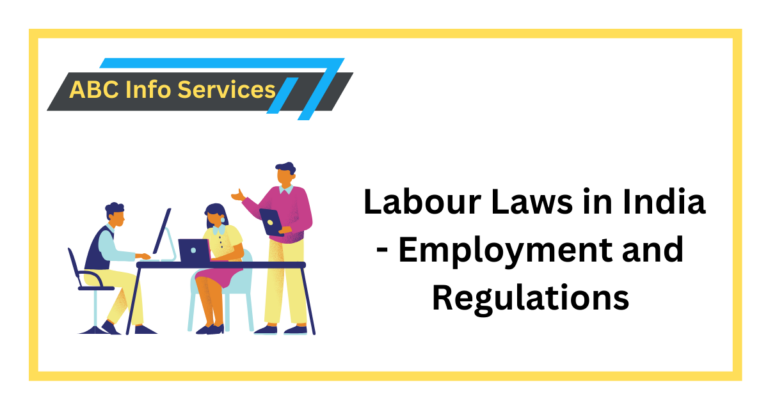This article provides detailed insights into the child labour laws and regulations to protect children's rights and prevent child labour in India.
Engaging children in performing labour duties is illegal in all Indian states. However, even today, it is a prevalent issue in Indian society depriving children of their childhood and taking a toll on their physical and mental development. The government has taken several steps to overcome this challenge and protect the rights of every child. Indian children under the right to education of The Indian Constitution are eligible to get free education. The government also adopts several other preventive measures to overcome the tough challenge.
However, poverty, the insufficient number of schools, and the economic imbalance that are still prevailing in Indian society are the primary cause of concern. These are the major causes for which the government of India is still struggling to overcome the issue of child labour law advisors.
What is Child Labour?
Child labour, commonly understood as work that deprives children of their childhood, potential, and dignity, involves tasks that are mentally, physically, socially, or morally harmful to children. It can also interfere with their ability to attend school regularly or fully, either by forcing them to leave prematurely or by burdening them with excessive workloads while attempting to balance school attendance.
This phenomenon is deeply intertwined with poverty, serving both as a consequence and a cause. Economic hardship often compels children to enter the labour market to contribute to their families’ income. However, this practice perpetuates a cycle of poverty as it denies children the opportunity to receive an education, hindering their prospects and impeding societal progress.
Age Limit for Employment in India
Employing children under the age of 14 for any type of labour is illegal and penalised. A maximum 2-year prison sentence will be imposed on a person who is found guilty of the same offence. However, some family-based jobs are exempt from the rule. Additionally, youths between the ages of 14 and 18 are not permitted to work in hazardous occupations. The Child Labour (Prohibition and Regulation) Amendment Bill, 2012 states that parents who put their children’s life in danger will also face punishment and be required to pay a fine.
Exceptions of Child Labour Law
Children under the age of 14 are not allowed to work in any government or private sector in India, as was previously mentioned. In some circumstances, there are, nonetheless, exceptions to this provision. When a child is running the family business, the law does not apply to them.
Hazardous jobs do not involve this kind of work. They are able to continue their careers after school or during breaks. The kid’s father, mother, sister, brother, paternal uncle or aunt, and maternal uncle or aunt are all considered family members under the law when it comes to protecting children from child labour.
Children under 14 years who appear as actors or actresses in the audio-visual entertainment sector are likewise protected from the regulation. Therefore, they are free to work in commercials, TV series, movies, or any other activities in the entertainment or sports industries. Circuses, on the other hand, are not regarded as part of India’s entertainment industry because they are subject to safety regulations and guidelines.
Work Permission for Teenagers Under the Child Labour (Prevention and Regulation) Amendment Act
According to the Child Labour (Prevention and Regulation) Amendment Act, young people between the ages of 14 and 18 are permitted to work in occupations that are not linked to difficult or dangerous tasks. The following standards must be upheld by any organisation that hires teens in order to guarantee their safety:
- Organisations should ensure that each working period must not exceed more than three hours each day
- Organisations are prohibited from employing adolescents during the night shift or from 7 PM to 8 AM
- According to the act, the maximum working time for a teenager is six hours each day, except for the waiting time
- After working for three hours, the organisation must allow the adolescent to take a break for at least an hour
- Teenagers between the age of 14 to 18 cannot work in more than one organisation simultaneously
- The organisation must allow teenagers to get a holiday at the weekends
- Adolescents are not allowed to work overtime.
Guidelines for Employing Teenagers in India
All Indian sectors or organisations hiring teenagers are required to keep a tab of the below-mentioned pointers:
- Name and the date of birth of the teenager hired by the organisation
- A record of the total hours and work periods of the adolescent. It must also mention the rest period allowed for the teenager
- Employment type, or the position for which the teenager has been selected.
Along with mentioning the above information, the employer must also submit the following details to the local inspector within 30 days of employing the teenager:
- Name and current situation of the organisation
- Name of the director or owner of the organisation
- Employee’s permanent address
- The kind of service provided by the organisation.
Consequences for Violating the Child Labour Laws
Engaging children as labourers is a punishable offence. Under the Child and Adolescent Labour (Prohibition and Regulation) Act, a person guilty of employing children or teenagers in hazardous tasks will be imprisoned for a minimum of 6 months. The maximum imprisonment for contravening the act is for two years. Furthermore, there will be a penalty of ₹20,000 to ₹50,000 and a jail sentence for the same offences.
Occupations and Processes Included in the Hazardous Work List
In India, children under 18 are not permitted to perform dangerous tasks. According to Section 3 of the Child and Adolescent Labour (Prohibition and Regulation) Act, the following are the occupations and processes that are classified as dangerous:
Occupations
Occupations that are directly or indirectly connected with
- Railway transportation of passengers, goods or mail
- Working in a railway station restaurant, including performing vendor activities from one platform to another
- Cleaning out an ash pit or engaging children in railway construction work or cinders scooping works
- Railway station or any railway construction work with any work between the railway lines or in railway crossings
- Engaged in selling or making crackers and fireworks in shops or factories with temporary or no licences
- A port authority that has been operating within the port’s boundaries
- Working in slaughterhouses
- Handloom and power loom industry
- Automobile workshop and garages
- Working in recreating centres including restaurants, roadside dhabas, motels, hotels, tea shops, resorts, and spas
- Metal and glass industries
- Industries engaged in the production of toxic, flammable, and explosive substances
- Diving and circus
- Workshops involved in the production of plastic and fibreglass
- domestic workers or servants
- Elephants’ caring services.
Processes
There are 65 processes in which children and teenagers can not be employed. Following are only some of the processes included in the Child and Adolescent Labour (Prohibition and Regulation) Act.
- Bidi-making and Carpet-weaving, including incidental and preparatory process
- Cement manufacturing and cement bagging
- Weaving, printing, and dyeing clothes, including incidental and preparatory process
- Soap manufacturing, wool-cleaning, and tanning
- Manufacturing of matches, fireworks, and explosives
- Manufacturing of shellac
- Cutting and splitting mica
- Manufacturing of hazardous products like mercury, lead, chromium, manganese, cadmium, pesticides, asbestos, and benzene
- ‘Dangerous operation’ rules under section 87 of the Factories Act, 1948 (63 of 1948) and ‘hazardous process’ under section 2(CB)
- Manufacturing of “agarbatti” and detergents
- Cutting and polishing of gemstones
- Food processing and beverage industries.
Conclusion
Child labour is a punishable offence, and the Government of India has listed the above-listed occupations as dangerous for them. Children and adolescents are prohibited from performing these jobs as they might be hazardous.The government of India seeks to safeguard every child’s development by enacting rules and regulations and ensuring the sound advancement of society. To learn more about the Child Right Protection Act and the steps taken by the Indian government to combat child labour, get in touch with reputable legal experts at Vakilsearch.
FAQs
What is the Child Labour Prohibition and Regulation Act 2016?
The Child Labour Prohibition and Regulation Act 2016 is legislation enacted in India to prohibit and regulate the employment of children in certain occupations and processes deemed hazardous. It aims to protect the rights and well-being of children by prohibiting their engagement in work that is harmful to their physical or mental health, safety, or moral development.
What does Article 24 of child labour entail?
Article 24 of the Indian Constitution prohibits the employment of children under the age of 14 in any factory, mine, or hazardous employment. It mandates that the state shall provide legislation for regulating the working conditions of children and ensuring their protection from exploitation.
Could you explain Section 14 of the Child Labour Act?
Section 14 of the Child Labour Act pertains to the punishment for employing a child in contravention of the provisions of the Act. It prescribes penalties, including fines and imprisonment, for employers found guilty of employing children in prohibited occupations or processes.
What are the key laws governing child labour in India?
The key laws governing child labour in India include the Child Labour Prohibition and Regulation Act, 1986 (amended in 2016), the Factories Act, 1948, the Mines Act, 1952, and various state-specific laws and regulations aimed at protecting children from exploitation and hazardous work conditions.
What is the latest Child Labour Act in India?
The latest Child Labour Act in India is the Child Labour Prohibition and Regulation Act, 2016. This legislation consolidates and strengthens previous laws related to child labour, providing comprehensive measures to prevent the employment of children in hazardous occupations and processes.
Is child labour considered a crime in India?
Yes, child labour is considered a crime in India. The employment of children under certain conditions, such as in hazardous occupations or processes, is prohibited by law, and violators can face legal consequences, including fines and imprisonment. The Indian government has taken various measures to combat child labour and protect the rights of children, including enacting stringent legislation and implementing social welfare programs.
Also, Read:










